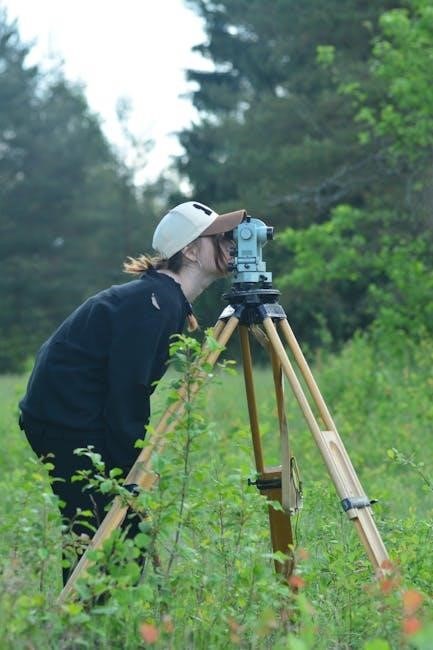Geotechnical engineering applies scientific principles to solve practical problems involving earth materials. It is a vital subset of civil engineering, focusing on soil, rock, and groundwater behavior.
1.1. Overview of Geotechnical Engineering
Geotechnical engineering is a branch of civil engineering that deals with the behavior of earth materials, such as soil and rock. It involves analyzing and designing structures that interact with the ground, including foundations, tunnels, and slopes. Geotechnical engineers use principles of mechanics, geology, and engineering to ensure the stability and safety of these structures. Key activities include site investigations, soil testing, and numerical analysis to predict ground behavior under various loads. The field also addresses environmental and seismic challenges, ensuring sustainable and resilient designs. By understanding the properties of earth materials, geotechnical engineers play a crucial role in constructing safe and efficient infrastructure. This expertise is essential for modern urban development and infrastructure projects.
1.2. Importance of Geotechnical Engineering in Civil Engineering
Geotechnical engineering is fundamental to civil engineering as it ensures the stability and safety of structures built on or within the earth. By analyzing soil, rock, and groundwater behavior, geotechnical engineers prevent failures and ensure structural integrity. This field is crucial for designing foundations, tunnels, slopes, and other infrastructure, making it indispensable for urban development. Site investigations and soil testing enable informed decision-making, reducing risks and costs. Geotechnical engineering also addresses environmental challenges, such as landslide prevention and groundwater management, ensuring sustainable and resilient designs. Its principles are essential for constructing safe, efficient, and durable infrastructure, making it a cornerstone of modern civil engineering practice and innovation.

Key Principles of Geotechnical Engineering
Key principles include soil mechanics, groundwater flow, and stress-strain behavior. These fundamentals guide the analysis and design of geotechnical structures, ensuring stability and safety.
2.1. Fundamental Concepts and Theories
Geotechnical engineering relies on core theories like effective stress, shear strength, and consolidation. These principles, developed by pioneers such as Terzaghi, form the basis for soil behavior analysis.
2.2. Soil Mechanics and Its Role in Geotechnical Engineering
Soil mechanics is central to geotechnical engineering, providing the theoretical framework for understanding soil properties and behavior. It encompasses stress-strain relationships, hydraulic conductivity, and shear strength, essential for designing foundations, tunnels, and slopes.

Soil Mechanics and Classification
Soil mechanics studies soil behavior under stress, crucial for construction projects. Classification systems like the Unified Soil Classification System help categorize soils, ensuring proper design and stability in geotechnical applications.
3.1. Soil Types and Their Properties
Soils are classified into primary types based on their particle sizes and properties. Gravel, sand, silt, and clay are common soil types, each with distinct characteristics. Gravel and sand are coarse-grained soils, known for high permeability and strength, while silt and clay are fine-grained, exhibiting plasticity and low permeability. Organic soils, such as peat, differ significantly due to their high organic content. Soil properties like density, shear strength, and compressibility are critical in geotechnical design. Understanding these properties helps engineers predict soil behavior under various loads, ensuring safe and efficient design of structures. Classification systems, such as the Unified Soil Classification System, further aid in categorizing soils for engineering applications.
3.2. Soil Classification Systems
Soil classification systems are essential tools for organizing and interpreting soil properties. The Unified Soil Classification System (USCS) and the AASHTO system are widely used. USCS categorizes soils based on grain size, plasticity, and organic content, grouping them into classes like clay (C), silt (M), and sand (S). AASHTO focuses on highway construction, emphasizing soil’s engineering properties for road design. These systems help predict soil behavior under different conditions, such as settlement, strength, and permeability. Accurate classification ensures proper material selection for construction projects, enhancing safety and efficiency. By standardizing soil types, these systems provide a common language for engineers, facilitating effective communication and consistent design practices globally.

Foundation Engineering Basics
Foundation engineering involves designing structures to transfer loads safely to the ground. It ensures stability, prevents settlement, and addresses soil-structure interaction, crucial for building integrity and durability.
4.1. Types of Foundations and Their Applications
Foundations are categorized into shallow and deep types, each suited for specific conditions. Shallow foundations, like pads and strips, are used for light loads and spread evenly. Deep foundations, including piles and caissons, transfer heavy loads to stable soil layers. Mat foundations support large structures by distributing loads over a wide area. Pile foundations are ideal for soft soils, driving piles to firmer ground. Spread footings are common in residential construction. Each type is selected based on soil properties, load requirements, and construction constraints. Proper selection ensures structural stability and prevents settlement issues, making foundations critical in geotechnical engineering. Understanding these types is essential for safe and efficient design.
4.2. Design Considerations for Safe and Efficient Foundations
Designing safe and efficient foundations requires careful consideration of soil properties, load-bearing capacities, and environmental factors. Engineers must assess the soil’s strength, stability, and settlement potential to ensure the foundation can support the structure without failure. Proper drainage and groundwater management are critical to prevent erosion and instability. The selection of foundation type depends on the building’s weight, soil conditions, and site constraints. Load distribution, settlement analysis, and material durability are key factors in the design process. Regular site investigations and laboratory testing provide essential data for accurate design decisions. Adhering to design codes and standards ensures compliance and reliability. By integrating these considerations, engineers can develop foundations that are both safe and efficient, minimizing risks and ensuring long-term structural integrity.

Site Investigation and Soil Testing
Site investigation involves exploring ground conditions to gather data on soil and rock properties. Soil testing provides critical insights for ensuring safe and efficient engineering designs.
5.1. Methods of Site Investigation
Site investigation involves various methods to explore and analyze ground conditions. Common techniques include geophysical surveys, which use non-invasive tools to map subsurface structures. Soil borings and trenching provide detailed information about soil layers and properties. Standard Penetration Tests (SPT) and Cone Penetration Tests (CPT) are widely used to determine soil strength and density. Additionally, field vane tests assess soil shear strength, while piezometers measure groundwater levels. These methods help identify potential geological hazards and ensure safe design parameters. By combining field observations with laboratory testing, engineers gather comprehensive data to support geotechnical designs and mitigate risks. Accurate site investigation is essential for reliable and efficient engineering projects.
5.2. Importance of Laboratory and Field Testing
Laboratory and field testing are crucial for understanding soil and rock properties. Laboratory tests, such as Atterberg Limits and triaxial shear tests, provide precise measurements of soil behavior under controlled conditions. These tests help determine parameters like shear strength and compressibility. Field tests, including Standard Penetration Tests (SPT) and Cone Penetration Tests (CPT), offer in-situ data, reflecting real ground conditions. Combining both methods ensures accurate soil characterization, which is vital for safe and efficient designs. Reliable data from these tests allows engineers to make informed decisions, preventing potential failures. This integration of laboratory and field testing is essential for advancing geotechnical engineering practices and ensuring the stability of structures.

Geotechnical Design and Analysis
Geotechnical design and analysis involve applying scientific principles to ensure the stability and safety of structures built on or in the ground, using advanced tools and methods.
6.1. Stability Analysis of Slopes and Structures
Stability analysis is crucial for evaluating the safety of slopes and geotechnical structures. It involves determining the balance between destabilizing forces, such as gravity and water pressure, and stabilizing forces, like soil strength. Engineers use various methods, including limit equilibrium and numerical modeling, to assess potential failures. Factors such as soil properties, groundwater levels, and external loads are considered. Advanced software tools enable detailed simulations to predict behavior under different conditions. Accurate analysis ensures the design of stable and durable structures, minimizing risks of collapses and ensuring long-term performance. This process is essential for preventing catastrophic failures in both natural and constructed slopes, safeguarding infrastructure and human life.
6.2. Numerical Methods in Geotechnical Design
Numerical methods play a pivotal role in modern geotechnical design, enabling engineers to analyze complex soil-structure interactions. Finite element analysis (FEA) and computational simulations are widely used to model stresses, strains, and deformations in geotechnical systems. These tools allow for precise predictions of how structures will behave under various loads and environmental conditions. Advanced software incorporates soil mechanics principles to simulate real-world scenarios, such as slope stability and groundwater flow. Numerical methods enhance design efficiency and accuracy, reducing reliance on physical prototypes; They also aid in optimizing foundation designs and assessing the impact of seismic activity. By leveraging numerical techniques, engineers can address challenges more effectively, ensuring safer and more sustainable geotechnical solutions.

Advanced Topics in Geotechnical Engineering
Advanced topics include geotechnical earthquake engineering, environmental geotechnics, and sustainability. These areas address seismic resilience, contaminated soil remediation, and eco-friendly construction practices, shaping modern engineering challenges.
7.1. Geotechnical Earthquake Engineering
Geotechnical earthquake engineering focuses on understanding soil behavior during seismic events. It addresses challenges like liquefaction, ground instability, and seismic-induced settlements. Key areas include analyzing soil-structure interaction, assessing seismic hazards, and designing resilient foundations. Engineers use advanced techniques such as dynamic soil testing and numerical modeling to predict ground response. Mitigation strategies include ground improvement methods like grouting and pile foundations. This field ensures infrastructure resilience, minimizing earthquake-induced damage to buildings, bridges, and underground structures. By integrating geotechnical principles with seismic design, engineers play a critical role in saving lives and reducing economic losses during earthquakes. This specialized area requires a deep understanding of soil mechanics, seismology, and structural engineering.
7.2. Environmental Geotechnics and Sustainability
Environmental geotechnics focuses on sustainable solutions for managing waste, contaminated land, and natural resources. It integrates geotechnical engineering with environmental science to address challenges like pollution mitigation and soil remediation. Key areas include landfill design, geosynthetic barriers, and groundwater protection. Sustainable practices aim to minimize environmental impact while ensuring structural safety. Techniques such as bioremediation and phytoremediation are used to restore contaminated sites. Geotechnical engineers play a crucial role in developing eco-friendly construction materials and methods. This field emphasizes the importance of balancing human development with environmental stewardship, ensuring long-term sustainability for future generations. By adopting green technologies and responsible practices, environmental geotechnics contributes to global efforts to combat climate change and preserve ecosystems.

Practical Applications and Case Studies
Geotechnical engineering is applied in various real-world projects, such as foundation systems, tunnels, and dams. Case studies provide insights into successful designs and lessons learned.
8.1. Real-World Examples of Geotechnical Engineering Projects
Geotechnical engineering is integral to large-scale infrastructure projects such as tunnels, dams, and high-rise buildings. For instance, the construction of the Channel Tunnel required meticulous soil analysis to ensure stability during excavation. Similarly, the Burj Khalifa relies on deep foundation systems designed to withstand extreme loads. These projects highlight the importance of understanding soil mechanics and foundation design. Geotechnical engineers use site investigations and laboratory testing to assess ground conditions, enabling safe and efficient construction. Real-world examples demonstrate how innovative solutions, such as pile foundations and retaining walls, address challenges like soil instability and groundwater pressure. These applications showcase the critical role of geotechnical engineering in modern infrastructure development, ensuring safety and sustainability. Detailed case studies are available in resources like textbooks and online courses.
8.2. Lessons Learned from Successful and Failed Projects
Analyzing successful and failed geotechnical projects provides invaluable insights into best practices and common pitfalls. Successful projects, such as the Channel Tunnel and Burj Khalifa, showcase the importance of thorough site investigations and innovative foundation designs. Failures, like the Leaning Tower of Pisa, highlight the consequences of inadequate soil analysis and foundation design. These case studies emphasize the need for accurate soil characterization, robust design methodologies, and continuous monitoring. They also underscore the importance of considering long-term soil behavior and environmental factors. By learning from both successes and failures, engineers can refine their approaches, improve safety, and enhance the reliability of geotechnical solutions. These lessons are extensively documented in resources like Geotechnical Engineering: Principles and Practices, offering practical guidance for future projects.

Future Trends and Innovations
Emerging technologies like AI and machine learning are transforming geotechnical engineering, enabling smarter designs and predictive analysis. Sustainability and advanced materials are key focuses for future innovations.
9.1. Emerging Technologies in Geotechnical Engineering
Emerging technologies like artificial intelligence (AI) and machine learning are revolutionizing geotechnical engineering. AI-driven simulations now enable precise modeling of soil behavior and structural stability. Advances in numerical methods, such as finite element analysis, enhance design accuracy. The integration of IoT sensors provides real-time monitoring of soil conditions and structural health. Sustainable practices, including biogeoengineering and green construction materials, are gaining prominence. These innovations not only improve safety but also reduce environmental impact. The adoption of 3D printing for geotechnical applications is another breakthrough, offering efficient solutions for complex structures. As these technologies evolve, they promise to address longstanding challenges in geotechnical engineering, ensuring more resilient and sustainable infrastructure.
9.2. The Role of Artificial Intelligence in Geotechnical Analysis
Artificial intelligence (AI) is transforming geotechnical analysis by enhancing predictive capabilities and data interpretation. Machine learning algorithms analyze vast datasets to predict soil behavior, such as settlement and strength, with high accuracy. AI models optimize foundation designs and slope stability assessments, reducing uncertainties. Natural language processing aids in automating report generation, improving efficiency. AI-driven tools also simulate real-time soil-structure interactions, enabling engineers to anticipate potential failures. These advancements not only improve the reliability of geotechnical projects but also reduce costs and environmental impact. AI’s role is pivotal in addressing complex challenges, making it an indispensable tool in modern geotechnical engineering practices.

Resources for Further Learning
Access the “Geotechnical Engineering: Principles and Practices” 2nd Edition for comprehensive insights. Explore recommended textbooks, online courses, and research articles for advanced learning and professional development.
10.1. Recommended Textbooks and Online Courses
and “Soil Mechanics and Foundation Engineering.” These courses complement the textbook by offering practical examples and interactive learning. For advanced topics, “Geotechnical Earthquake Engineering” and “Environmental Geotechnics” courses are highly recommended. Utilize these resources to enhance your understanding and skills in geotechnical engineering.
10.2. Accessing the “Geotechnical Engineering: Principles and Practices” 2nd Edition
To access the “Geotechnical Engineering: Principles and Practices” 2nd Edition, you can explore various options. Many university libraries offer physical copies or digital versions through their databases. Additionally, online retailers like Amazon provide both paperback and Kindle editions. For a free PDF version, several academic platforms and forums may offer downloads, though ensuring copyright compliance is essential. Some institutions provide access through subscriptions or open-access initiatives. Purchasing directly from the publisher guarantees an authentic copy with additional resources. Always verify the source for reliability and respect intellectual property rights when accessing this valuable resource.




